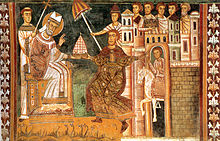
Back Bisbes de Roma sota Constantí I Catalan Obispos de Roma bajo Constantino I Spanish اسقفهای روم در زمان کنستانتینوس بزرگ Persian Uskup Roma di bawah Konstantinus Agung ID


Constantine the Great's (272–337) relationship with the four Bishops of Rome during his reign is an important component of the history of the Papacy, and more generally the history of the Catholic Church.
The legend surrounding Constantine I's victory in the Battle of the Milvian Bridge (312) relates his vision of the Chi Rho (☧) and the text in hoc signo vinces in the sky and his reproducing this symbol on the shields of his troops. The following year Constantine and Licinius proclaimed the toleration of Christianity with the Edict of Milan, and in 325 Constantine convened and presided over the First Council of Nicaea, the first ecumenical council. None of this, however, has particularly much to do with the popes, who did not even attend the Council; in fact, the first bishop of Rome to be contemporaneously referred to as "Pope" (πάππας, or pappas) is Damasus I (366-384).[1] Moreover, between 324 and 330, he built Constantinople as a new capital for the empire, and—with no apologies to the Roman community of Christians—relocated key Roman families and translated many Christian relics to the new churches.
The Donation of Constantine, an 8th-century forgery used to enhance the prestige and authority of popes, places the pope more centrally in the narrative of Constantinian Christianity. The legend of the Donation claims that Constantine offered his crown to Sylvester I (314-335), and even that Sylvester baptized Constantine. In reality, Constantine was baptized (nearing his death in May 337) by Eusebius of Nicomedia, who, unlike the pope, was an Arian bishop of Constantinople. Sylvester was succeeded by Mark (336) and Julius I (337-352) during the life of Constantine.
Although the "Donation" never occurred, Constantine did hand over the Lateran Palace to the bishop of Rome, and began the construction of Old Saint Peter's Basilica (the "Constantinian Basilica"). The gift of the Lateran probably occurred during the reign of Miltiades (311-314), Sylvester I's predecessor, who began using it as his residence. Old St. Peter's was begun between 326 and 330 and would have taken three decades to complete, long after the death of Constantine. Constantine's legalization of Christianity, combined with the donation of these properties, gave the bishop of Rome an unprecedented level of temporal power, for the first time creating an incentive for secular leaders to interfere with papal succession.
- ^ Baumgartner, 2003, p. 6.